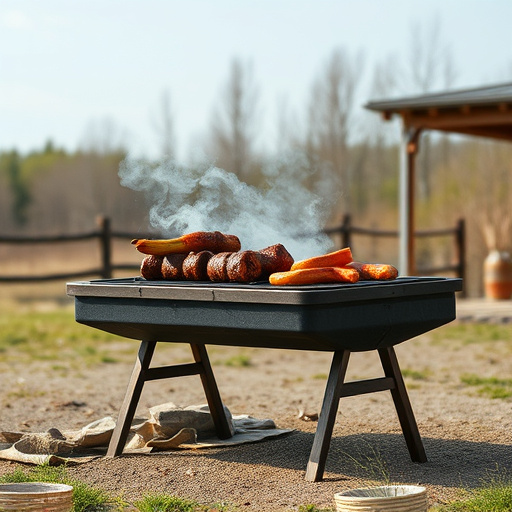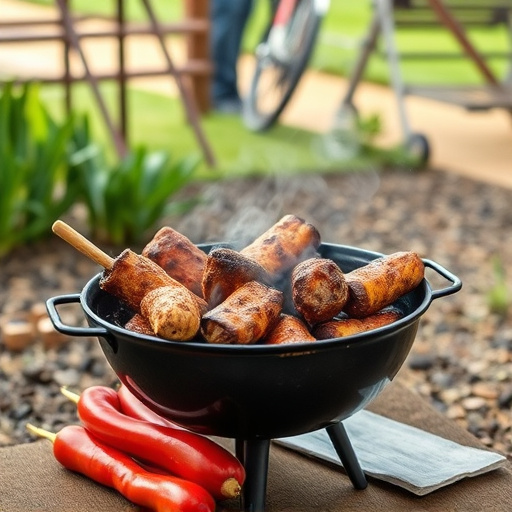Selecting the right cut with good marbling, using slow cooking methods and precise temperature control, mastering seasoning techniques, and proper slicing ensure a perfect BBQ brisket recipe. Avoiding common mistakes like underestimating cook time, neglecting trussing, and excessive seasoning is key. Creative side dishes and toppings elevate the visual appeal while traditional or adventurous pairings enhance the dining experience.
“Unleash your inner barbecue master with the ultimate guide to crafting the perfect sliced brisket. This comprehensive journey delves into every critical aspect of achieving that coveted bark and tender, juicy meat. From selecting the ideal cut to mastering temperature control and seasoning secrets, we’ll equip you with the knowledge for BBQ brisket recipe perfection. Prepare to amaze your taste buds and impress your guests.”
- Choosing the Right Brisket Cut for Optimal Flavor
- Seasoning 101: The Magic Mix for a Delicious Bark
- Smoking Techniques to Achieve the Perfect Texture
- Mastering the Temperature Game: How Low Should You Go?
- Slicing Tips: Unlocking the Secret to Tender, Even Slices
- Common Mistakes to Avoid When Cooking BBQ Brisket
- Pairing Suggestions: Accompaning Your Sliced Brisket Delight
- Presentation Ideas: Serving Your Culinary Masterpiece
Choosing the Right Brisket Cut for Optimal Flavor

When it comes to a mouthwatering BBQ brisket recipe, selecting the right cut is key to unlocking its optimal flavor potential. Look for a packer brisket with good marbling; this means fat streaks evenly distributed throughout the meat. The fat acts as a natural moisture barrier during slow cooking, ensuring your brisket remains tender and juicy. Avoid flat cuts, which can be tougher due to less favorable muscle fibers. A well-marbled packer cut will provide a rich, smoky taste that is the hallmark of a perfect BBQ brisket.
The bark, or crust, on the brisket is not just for show; it’s a flavor-packed exterior that signals a successful smoking process. Aim for a thick, crispy bark by using a slow cooking method like smoking over low heat. This allows the natural juices to render the fat, creating a tender interior and a satisfyingly crunchy exterior—a true delight for BBQ enthusiasts.
Seasoning 101: The Magic Mix for a Delicious Bark

Seasoning plays a crucial role in transforming a simple piece of beef into a mouthwatering BBQ brisket recipe. The magic mix for achieving that perfect, crispy bark lies in balancing spices to create a complex and savoury flavour profile. A blend of salt, pepper, garlic powder, and paprika is a solid starting point, providing a robust foundation for your brisket’s delicious development.
This initial seasoning not only enhances the meat’s natural juices but also encourages the formation of that desirable crust. For an extra kick, consider adding a touch of cayenne or chili powder to give your bark a subtle heat. Remember, the key is to pat the seasoning into the meat, ensuring each fibre absorbs the flavour, resulting in a tender and aromatic BBQ brisket that’s sure to impress.
Smoking Techniques to Achieve the Perfect Texture

Achieving the perfect texture in your BBQ brisket recipe is an art, and smoking techniques play a pivotal role. The key lies in understanding that slow and steady wins the race when it comes to smoking meat. A low-and-slow approach ensures that the brisket cooks evenly, resulting in tender, juicy flesh with a desirable bark.
Most experts recommend using a combination of direct heat and indirect heat during the smoking process. This typically involves placing the brisket on a rack over a bed of smoking wood chips or chunks, then controlling the temperature inside your smoker. Maintaining a consistent temperature between 225°F to 250°F (107°C to 121°C) is ideal for slow-roasting the brisket. This method allows the exterior to develop that crisp, crunchy bark while keeping the interior incredibly tender and full of flavor. Regularly checking the temperature and adding wood chips as needed will help you achieve the perfect BBQ brisket every time.
Mastering the Temperature Game: How Low Should You Go?

Mastering the art of cooking brisket involves a delicate dance with temperature control, especially when aiming for that perfect bark and tender meat. The low-and-slow method is revered in the world of BBQ brisket recipes, as it allows the collagen in the meat to break down gradually, resulting in incredibly tender slices. Typically, slow cooking at temperatures between 225°F to 250°F (107°C to 121°C) for several hours ensures a juicy, flavorful brisket.
Going too low might slow the process excessively, while exceeding 250°F can result in overcooking and drying out the meat. The key is patience—letting time do its magic as the heat gently transforms the tough brisket into something melt-in-your-mouth delicious. This precise temperature control is what sets apart a good BBQ brisket recipe from a truly exceptional one, creating that coveted bark without sacrificing tenderness.
Slicing Tips: Unlocking the Secret to Tender, Even Slices

When it comes to serving up a mouthwatering BBQ brisket recipe, the secret lies in the slicing. Achieving even and tender slices is key to satisfying every beef-loving guest. The first step is to let the brisket rest after slow cooking; this allows for those delicious juices to redistribute, ensuring each slice is moist and succulent.
Use a sharp, thin knife to slice against the grain of the meat, as this prevents tough fibers. Starting from one end and working your way through, cut thin slices until you reach the bone. This method ensures an even cook throughout, resulting in a perfectly tender brisket that’s sure to impress at any BBQ gathering.
Common Mistakes to Avoid When Cooking BBQ Brisket

When it comes to crafting the perfect BBQ brisket, there are a few common pitfalls to steer clear of. One of the most frequent mistakes is underestimating the time required for slow-cooking. Brisket demands patience; rushing the process can result in tough, chewy meat. It’s essential to stick to the recommended cooking times and let the low and slow method do its magic.
Another blunder is inadequate trussing or seasoning. Trussing helps retain moisture and promotes even cooking. Neglecting this step can lead to a dry, unappetizing final product. As for seasoning, while a robust rub is key, excessive application can burn the exterior before the interior cooks fully. A light, even hand with the rub will ensure a delightful bark without overpowering the delicate meat. Remember, these mistakes are easily avoided with a little knowledge and attention to detail.
Pairing Suggestions: Accompaning Your Sliced Brisket Delight

When it comes to pairing your perfectly sliced BBQ brisket, the options are endless. For a classic combination, serve it with creamy coleslaw—the contrast of tender brisket and crisp vegetables is a favorite among many. Alternatively, opt for a hearty side of homemade potato salad; the rich flavors complement the smoky meat.
For a more adventurous pairing, consider a robust BBQ sauce or a zesty citrus-based marinade to enhance the brisket’s natural flavor. Pairing your delicious BBQ brisket recipe with a refreshing beer or a smooth bourbon can also elevate the overall dining experience.
Presentation Ideas: Serving Your Culinary Masterpiece

When presenting your perfectly sliced BBQ brisket recipe, think beyond the traditional plate. Consider arranging it on a bed of creamy coleslaw or crispy potato wedges for a balanced and visually appealing dish. You can also embrace the bold flavors by serving it with a side of charred vegetables or smoky bean casserole. For an elegant touch, pair your brisket with a rich sauce drizzled on top and a side of fresh, crisp salad. The presentation should complement the richness and depth of the BBQ brisket recipe, allowing each element to shine while creating a harmonious culinary experience.
